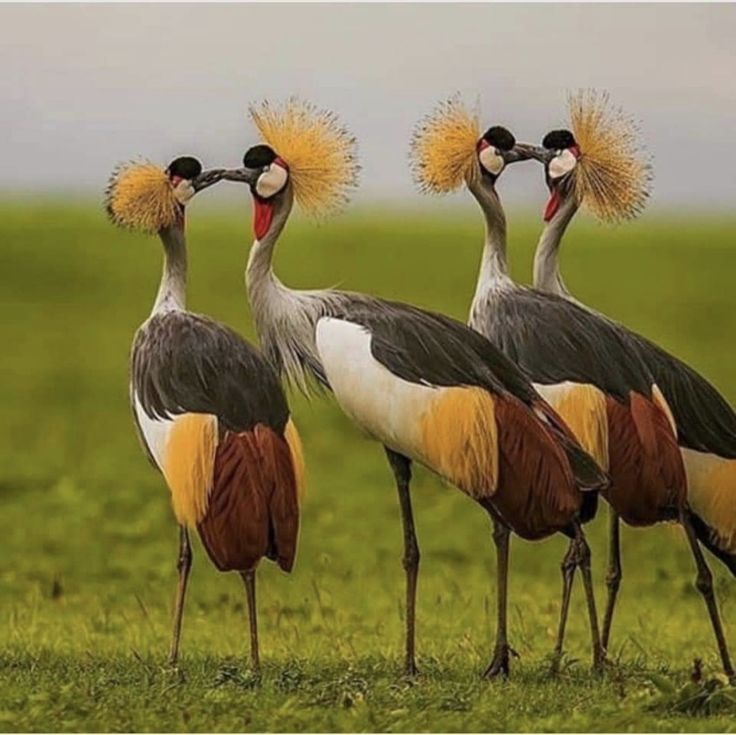The Uganda Crested Crane
The Uganda Crested Crane is not just a bird but an iconic symbol of Uganda, representing the country’s rich culture and natural beauty. As the national emblem, this crane is deeply woven into the nation’s identity and plays a central role in the pride of the Ugandan people. Beyond its symbolism, the Crested Crane is a striking and majestic bird that captures the attention of nature lovers and visitors from all over the world. Let’s take a closer look at the Uganda Crested Crane and what makes it so special.
Significance as Uganda’s National Symbol
The Uganda Crested Crane holds great cultural and national significance. It appears prominently on the coats of arms and flags of Uganda, symbolizing unity, resilience, and hope. For many Ugandans, this bird represents the strength of the nation and its diverse wildlife. The crane’s beauty and grace reflect the peaceful aspirations of the country, making it a fitting emblem for Uganda’s values and heritage.
Scientific Classification and Name
The Uganda Crested Crane belongs to the family Gruidae and the scientific name Balearica regulorum gibbericeps. This subspecies is a part of the Grey Crowned Crane family, which is found across parts of Africa. While similar in many ways to other crowned cranes, the Uganda Crested Crane has distinctive features that make it stand out.
Physical Features of the Uganda Crested Crane
One of the most recognizable features of the Uganda Crested Crane is its golden crown made up of stiff, golden feathers on top of its head. This crown, along with its long legs and slender frame, makes the crane look elegant and stately. Here are some other important physical characteristics:
- Height: The crane stands about 90 cm (3 feet) tall.
- Coloration: It has a mix of gray and white feathers on its body, with the upper part of the body being light gray and its wings dark gray or black. Its feathers blend beautifully with its surroundings.
- Face and Crest: The crane has a white face with a distinctive red patch on the cheeks and dark lines around its eyes. The bright yellow crown of feathers on top of its head is its signature feature.
- Legs and Feet: The crane’s long legs are typically gray or black and well adapted to walking in marshy areas or shallow water.
Where Does the Uganda Crested Crane Live?
The Uganda Crested Crane is primarily found in Uganda, where it inhabits a variety of landscapes, from wetlands to grasslands. It is commonly seen around Lake Victoria, Lake Albert, and the wetlands surrounding these lakes. Other notable habitats include:
- Wetlands and Marshes: The crane thrives in wetlands, which provide abundant food and a safe place to nest.
- Grasslands and Savannas: Open fields and grasslands also attract the crane, offering them space to forage and socialize.
- Farmlands: The Uganda Crested Crane has adapted well to living near farmlands, where it feeds on grains and other crops.
What Does the Uganda Crested Crane Eat?
The Uganda Crested Crane is an omnivore, meaning it eats a variety of foods. Its diet typically consists of:
- Grains and Seeds: Often found in agricultural fields, making them a common sight in farming areas.
- Insects and Small Animals: It also feeds on grasshoppers, beetles, and other small animals.
- Aquatic Plants: The crane eats plants found in shallow water and marshes.
In large groups, the cranes often forage together. These social birds enjoy foraging in family units, making their feeding time a group activity.
Breeding and Nesting Habits
The Uganda Crested Crane has a monogamous mating system, and pairs tend to stay together for long periods. The breeding season usually occurs during the rainy season, when food is abundant. The crane engages in impressive courtship displays, involving dancing, bowing, and calling to attract a mate.
- Nests: The female lays two eggs, which are incubated by both parents for about 28-30 days. The nest is typically built in tall grass or on floating platforms in shallow waters. These nests are well-camouflaged, protecting the eggs from predators.
- Chicks: When the eggs hatch, the chicks are precocial, meaning they are born with their eyes open and can walk almost immediately. Both parents care for the chicks, ensuring their survival.
Social Behavior and Migration
The Uganda Crested Crane is a highly social bird. It is often found in groups or flocks, especially during feeding or migration. They communicate with each other through distinctive calls, which can be heard from long distances. The calls of the crane are often described as loud trumpeting sounds, which echo across their habitat.
While the Uganda Crested Crane is not a migratory bird, it may shift its range seasonally in search of better feeding grounds. However, it does not travel long distances like some migratory species.
Conservation Status and Threats
The Uganda Crested Crane is currently listed as a species of Least Concern by the International Union for Conservation of Nature (IUCN). However, like many birds, it faces threats, mainly from habitat loss and degradation. The draining of wetlands for agriculture, along with the expansion of urban areas, poses a significant threat to the crane’s habitat.
Conservation efforts have been put in place to protect the crane and its habitat, including the creation of wetland reserves and raising awareness about the importance of preserving these ecosystems. Conservationists are working with local communities to ensure that these wetlands are protected for future generations.
Cultural Significance
The Uganda Crested Crane is a powerful symbol in Ugandan culture. It is featured prominently on Uganda’s national flag, coats of arms, and currency, making it an integral part of the country’s identity. The crane represents peace, prosperity, and unity, reflecting the country’s hopes for progress and cooperation among its people.
The crane also holds symbolic value in Ugandan folklore, often associated with grace and beauty. Its presence in various ceremonies and national celebrations serves as a reminder of Uganda’s natural wealth.
Where to See the Uganda Crested Crane
The Uganda Crested Crane can be seen in a variety of locations across the country. Some of the best places to spot the crane include:
- Queen Elizabeth National Park: A prime location for birdwatching, where you can find Crested Cranes in their natural habitat.
- Murchison Falls National Park: Known for its diverse wildlife, this park is also home to many Crested Cranes.
- Kibale Forest National Park: This park, famous for its chimpanzee trekking, is another excellent spot to see the crane.
- Lake Victoria and Lake Albert: The surrounding wetlands of these lakes are rich in wildlife, including the Crested Crane.
Conclusion
The Crested Crane is not only an extraordinary bird but also a cherished national symbol. Its elegant appearance, distinctive features, and cultural significance make it one of the most important birds in Uganda. The crane represents the beauty and resilience of Uganda’s natural heritage and continues to inspire pride in the country’s identity. By protecting their habitats and promoting conservation efforts, we can ensure that this magnificent bird continues to grace Uganda’s skies for generations to come.




